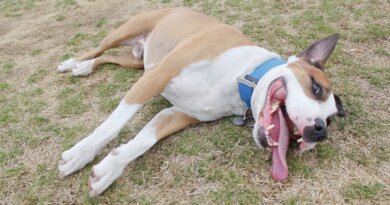How Safe Is It and What Pet Owners Must Be Aware Of
Your dog needs surgery, and your heart is focused on the immediate needs of your pet. The surgery could be for an injury, illness or maybe it’s even a routine dental cleaning. The experience can be overwhelming, because you’re worried about the safety of sedation and dog anesthesia that is going to be used.
While there are risks involved with both, the risks can be minimized by your veterinarian through careful planning and preparation. With the use of better drugs and safety protocols, anesthesia in dogs is relatively safe, and studies show that anesthetic-related death rate among healthy dogs is between 0.05% and 0.12% while for sick animals the death rate is around 4.77% and is actually higher in cats than in dogs (1, 2).
As technology has advanced and more research has been done, veterinary anesthesia has become much safer than it was many years ago, which is where fears of it come from. But the negative stigma attached to the anesthetic procedure is still lingering around, and much of this “scare” information is not true (3).
If you’re concerned about dog anesthesia, the best thing you can do is talk with your veterinarian and do your due diligence on how pet anesthesia can affect your dog. A vet would never recommend anything that is going to do harm to your pet. They’ll explain dog anesthesia risks and help you make a choice about the right option.
Sedation vs. Anesthesia
Dogs will undergo either general anesthesia with sedation, or just sedation alone (4).
When you discuss this with your veterinarian, you can talk about the degree of sedation or anesthesia that your dog will be under. It will depend upon the procedure, the reasons either option is being used, and how invasive that it will be to your dog.
In many cases, and especially with senior dogs, a low dosage of a mild sedative drug such as acepromazine will be used (5). This is to ensure a stress-free environment for the animal. Sedation can be used for minor procedures that are less invasive to your dog such as x-rays, ultra-sound, and minor wounds.
Sometimes, an one of the four opioids – morphine, pethidine, buprenorphine or butorphanol – might be combined with the sedative drug to increase sedative effects (6).
Emergency surgeries and more invasive procedures require a deeper anesthesia and a breathing tube (7). Drugs like thiopentone and propofol will be used in such cases to induce anasthesia in the dog.
When your dog undergoes general anesthesia, they will be completely unconscious during the procedure as opposed to being simply sedated. Your veterinarian will go over the risks that are involved with your dog’s surgery and the risks of anesthesia for your dog.
What are the Risks of Dog Anesthesia?
Every surgery has its own particular risks, but there also are risks involved with the drugs used and generally inducing anesthesia in dogs. These risks can vary according to your pets’ health and current medical conditions, and especially your dog’s age and weight.
1. Dog’s Age
Your dog’s age is the biggest factor in how risky anesthesia will be, with studies showing increased mortality among seniors due to concurrent diseases (8). Another reason for increased anaesthetic morbidity among senior dogs is due to weakened or decreased organ function (9).
Older dogs may have low blood pressure or diabetes, which also increases the chances of loss of organ function during the surgery. They tend to suffer from arthritis, which means that their joints have to be protected during the procedure.
If your dog is elderly and especially if they have multiple health issues, anesthesia may sometimes need to be reconsidered if the risks outweigh the benefits. This is why veterinarians place paramount importance on pre-anaesthetic assessment (10).
Complications can be avoided or reduced by preparing for the anesthesia ahead of time by going over your dog’s health history and having your veterinarian do a baseline blood work up to look for any unidentified problems.
2. Medical Conditions
Pre-existing medical conditions can complicate and make the risks for canine anesthesia higher. The mortality rate is very low for healthy dogs, but dogs with pre-existing conditions the mortality rate goes up.
Some of the conditions related to functioning of the dog’s body that can be negatively affected by anesthesia, and particularly in senior dogs, include:
- Respiratory system (11, 12, 13)
- Cardiovascular system (14, 15, 16)
- Central nervous system (17, 18)
- Renal system (19, 20)
- Hepatic system (21)
- “Fight or flight response” (22)
You should discuss with your veterinarian all pre-existing conditions. Ask if there is an anesthesiologist on staff, or find a specialty office if your dog has any type of heart, airway or other serious disease and will require a longer procedure.
Your veterinarian will help you get any current medical conditions under control prior to surgery (23). A full baseline of bloodwork will be done before surgery to determine if your dog has any other conditions, and allow the anesthesiologist to get an accurate determination of your dog’s current state of health.
3. Dog’s Weight
Your dog should be weighed to get an accurate weight before surgery because. Drug dosages for general anesthesia are determined by the weight and the overall health of your dog (24, 25).
If you have a smaller dog, the anesthesia may take longer to wear off. The drugs create a more profound effect on your dog and lasts longer because there is less fat to distribute the drug. Your dog may be colder and it will be important to keep your dog warm during surgery because of a drop-in blood pressure and metabolic rate.
If your dog is overweight, surgery under anesthesia can carry higher risk. Dogs that are heavy can be hard to position during procedures and may have difficulty breathing. In many case the larger dogs will not be able to breathe on their own and have breathing tubes inserted.
4. Breed
Your dog’s breed may have a higher risk for complications during anesthesia or surgeries than other dogs (26, 27). Your veterinarian will be able to discuss these different types of risks with you, and go over your dog’s specific medical history with you.
Some breeds with shorter noses, like a Pekingese or a Pug, are more difficult to sedate. This is due to the shape of their shorter noses and smaller nasal passages. This can lead to airway issues during surgery.
Other dog breeds can have a history of what is known as tracheal collapse. Poodles and Pomeranians are both high risk breeds for this condition. Your veterinarian will be able to treat your dog with medications after the surgery to reduce the chance of infection.
Tracheal collapse is considered a chronic progressive condition, so your veterinarian will note this for the future. If your dog requires surgery again, it will be left intubated after surgery for as long as possible to allow for a better chance of recovery with fewer problems.
What to Be Aware Of
One of the first things to think about when considering the risks involved with a dog undergoing anesthesia is who is going to sedate your pet?
When you go to the hospital for surgery, you have a specialist, but when your dog goes to the veterinarian, it can be just the doctor and their staff. It is important to know who is going to anesthetize your dog, and what their credentials are.
Your veterinarian may have certified technicians who are trained to handle veterinarian anesthesia. They are trained to monitor vital signs, respiration, oxygenation, and heart rhythm. If there is a change in vital signs they are capable of handling it right away.
If you are worried, you can ask from your veterinarian the credentials of the person who will be monitoring your dog’s anesthesia. You can ask for a specialist or anesthesiologist.
Dog’s Recovery Post-Anesthesia
You may also want to follow up with a vet regarding the recovery period. Ask where your dog will be during the post-surgery and what it will be like for your dog. Will your dog be in any pain? Your veterinarian will recommend and begin a pain management program for your dog right away.
During recovery, a nurse or technician will monitor your dog’s blood pressure, respiration, and oxygen levels. This is done about every 10 minutes until your dog is ready to go home. Your veterinarian may recommend follow-up care, medications, physical therapy and return visits.
Once your dog is home, taking it slow is key. Allow your pet the space it needs to recover, and keep other pets away. You may have to isolate your dog in a room by itself to give it the time and quiet it needs to heal and recover.
READ NEXT: How To Check A Dog’s Heart Rate At Home




